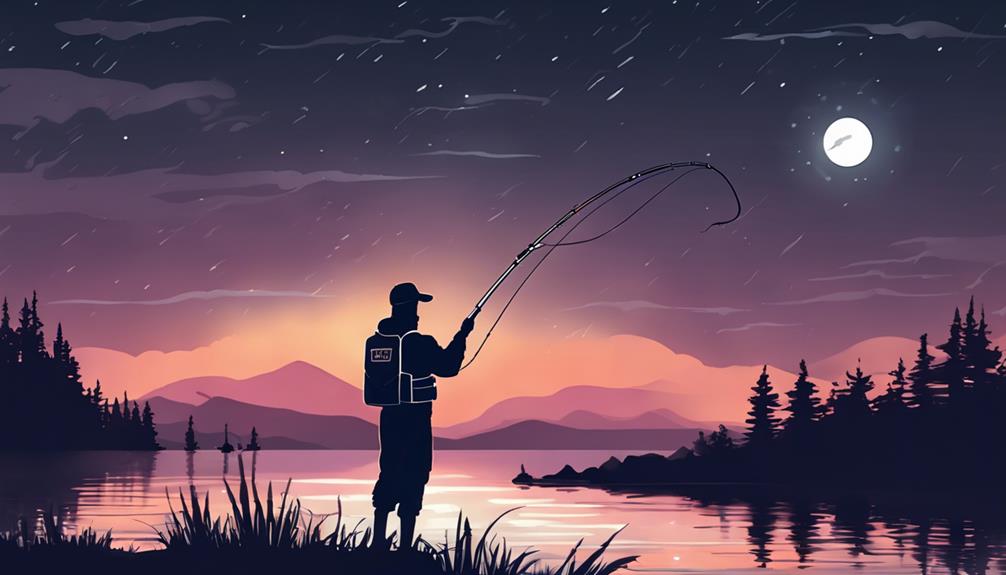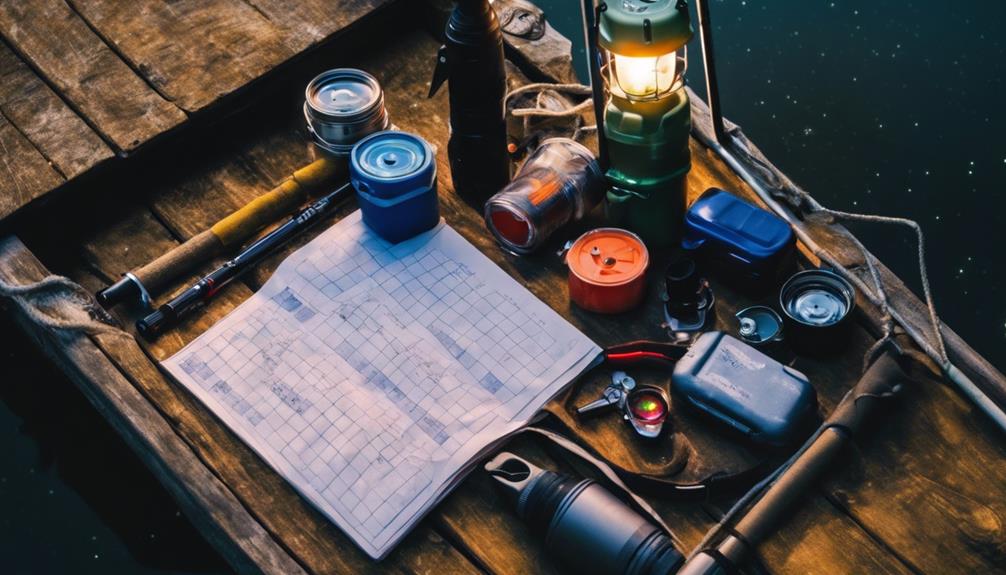Night fishing is highly effective for catching catfish. They are most active during the night, utilizing their nocturnal feeding patterns. Their enhanced sensitivity to low light conditions increases hunting success rates. Catfish are biologically inclined for night feeding, optimizing their sensory adaptations for prey detection. Using specialized gear like night vision technology and bait with scent attractants boosts angling outcomes. Understanding catfish behavior and strategic fishing techniques during the night can further maximize your catches. To learn more about the benefits, gear, bait selection, and success strategies for night fishing catfish, explore the detailed insights provided.
Benefits of Night Fishing for Catfish
Night fishing for catfish offers increased opportunities for successful catches due to the feeding behavior of catfish being more active during the nighttime hours. Catfish are known to be primarily nocturnal feeders, which means they're more active and on the prowl for food during the night. This behavior is influenced by various factors, including the reduction in light intensity, which makes it easier for catfish to hunt prey without being easily detected by potential threats. Research has shown that catfish possess a heightened sensitivity to low light conditions, enhancing their ability to locate and consume food efficiently during nighttime hours.
Moreover, catfish feeding patterns are closely linked to their biological clocks, with many species exhibiting a preference for feeding during the cover of darkness. This unique adaptation allows catfish to capitalize on the abundance of food sources that are more readily available at night, giving anglers a strategic advantage when targeting these elusive fish. The increased nighttime activity of catfish not only improves the chances of successful catches but also presents a compelling opportunity for anglers to engage in a thrilling fishing experience under the stars.
Understanding the nuances of catfish feeding behavior and their propensity for nighttime activity is crucial for optimizing fishing strategies and increasing overall catch rates. By leveraging this knowledge, anglers can harness the natural instincts of catfish to their advantage, ultimately enhancing the effectiveness of night fishing expeditions.
Understanding Catfish Behavior at Night
To comprehend catfish behavior at night thoroughly, it's imperative to consider their heightened sensitivity to low light conditions and their biological inclination for nocturnal feeding. Catfish exhibit fascinating behaviors during nighttime hours, shaped by their evolutionary adaptations for hunting and survival. Understanding these nocturnal habits can significantly enhance your night fishing success. Here are three key aspects to consider:
- Nocturnal Habits: Catfish are primarily nocturnal creatures, meaning they're most active during the night. This behavior is influenced by factors such as reduced predation risk and increased prey availability under the cover of darkness. By tapping into their natural rhythm, anglers can capitalize on catfish feeding patterns when they're most actively hunting for food.
- Feeding Patterns: The darkness of night provides catfish with a strategic advantage for hunting. Their sensory adaptations, such as heightened sensitivity to vibrations and smells, allow them to locate prey with precision in low visibility conditions. Catfish are opportunistic feeders, preying on various aquatic organisms like insects, crustaceans, and smaller fish under the veil of darkness.
- Sensory Adaptations and Hunting Strategies: Catfish possess specialized sensory organs, including chemoreceptors and lateral lines, that aid in detecting food sources. These adaptations, coupled with their ambush hunting style, make them formidable predators in dimly lit environments. By understanding how catfish use their senses to locate and capture prey at night, anglers can optimize their bait presentation and increase their chances of a successful catch.
Essential Gear for Night Fishing
When preparing for night fishing, essential gear must include specialized equipment optimized for low-light conditions and enhanced sensory perception. Night vision technology is crucial for navigating in the dark and spotting catfish movement underwater. High-quality night vision goggles or scopes can provide a clear view of your surroundings, helping you locate potential fishing spots and monitor your lines with ease.
Glow sticks are another indispensable tool for night fishing. These chemical light sticks can be attached to your fishing rod to help you see when a catfish bites. By using different colors, you can even differentiate between multiple rods to quickly identify which one has a catch. Glow sticks are lightweight, reliable, and a cost-effective way to enhance your visibility during nighttime angling.
In addition to night vision and glow sticks, having a reliable headlamp is essential for hands-free illumination. Choose a headlamp with red light mode to preserve your night vision while providing sufficient brightness to handle tackle and bait. Furthermore, wearing polarized sunglasses can help reduce glare from the water's surface, improving your ability to see underwater movements and potential catfish strikes.
Best Baits for Catfish at Night
Navigating the realm of catfish night fishing requires a keen understanding of the most effective baits to lure these nocturnal predators. When it comes to catfish, selecting the right bait can significantly increase your chances of a successful fishing trip. Here are some key considerations to keep in mind:
- Live Bait vs Artificial: Catfish are known for their keen sense of smell and taste, making live bait a popular choice among anglers. Live baits such as nightcrawlers, minnows, and shad can be highly effective in attracting catfish due to their natural movements and scents. On the other hand, artificial baits like plastic worms, dough baits, and chicken livers can also yield positive results if they're designed to mimic the scent and texture of real bait.
- Scent Attractants: Catfish rely heavily on their sense of smell to locate food in murky waters, making scent attractants a valuable tool for night fishing. Adding scents like anise oil, blood, garlic, or commercial catfish attractants to your bait can help create a strong scent trail that leads catfish straight to your hook. Experimenting with different scents and observing which ones yield the best results in your fishing spot can help you fine-tune your bait selection for maximum effectiveness.
Setting Up Your Night Fishing Spot
Selecting an optimal location plays a crucial role in maximizing your success when setting up your night fishing spot for catfish. When considering night fishing logistics, it's essential to choose a spot with easy access to the water, ample space for your equipment, and a strategic position that catfish are known to frequent. Optimal lighting is another key factor to take into account. While catfish are less sensitive to light than some other fish species, having some form of illumination can be beneficial for attracting them to your bait. Green or white lights are often preferred as they're less likely to spook the catfish compared to brighter colors.
To set up your night fishing spot effectively, consider using a portable light source such as a lantern or submersible fishing light. These lights can help attract plankton and baitfish, which in turn draw in the catfish. Additionally, ensure that your fishing spot is in a quiet area away from disturbances that could scare off the catfish. By creating a calm and well-lit environment, you're increasing your chances of a successful night fishing expedition. Remember to check local regulations regarding the use of lights while fishing at night to ensure you're in compliance with the law.
Techniques for Night Fishing Success
To increase your chances of success in night fishing for catfish, employ effective techniques tailored to the behavior of these nocturnal predators. Catfish are more active during certain moon phases, so understanding these patterns can significantly improve your catch rate. Fishing lights play a crucial role in attracting catfish to your bait, making them essential for a successful night fishing trip. Here are three key techniques to enhance your night fishing success:
- Consider the Moon Phase: Catfish tend to be more active during the night when there's a full moon. During this phase, the increased light can stimulate feeding behavior in catfish, making them easier to catch. Plan your night fishing trips around the lunar calendar to capitalize on these peak activity periods.
- Use Fishing Lights Strategically: Fishing lights can attract insects and small baitfish, drawing catfish to the illuminated area. Position your fishing lights strategically to create a concentration of prey that will entice catfish to feed. Ensure your lights are bright enough to attract catfish but not too overpowering that they scare the fish away.
- Experiment with Light Colors: Different colors of fishing lights can have varying effects on catfish behavior. Some anglers find success with green lights, while others prefer white or blue. Experiment with different light colors to see which one yields the best results in your fishing location.
Safety Tips for Night Fishing

For safe night fishing outings targeting catfish, prioritize equipping yourself with essential safety gear and knowledge to mitigate potential risks. Emergency preparedness is crucial when night fishing. Always carry a fully charged mobile phone in a waterproof case in case of emergencies. Additionally, pack a first aid kit containing basic supplies such as bandages, antiseptic wipes, and pain relievers. Knowing how to handle emergencies like hook injuries or accidental falls into the water is essential for a safe fishing experience.
Navigation skills are equally important for a safe night fishing trip. Familiarize yourself with the fishing location during daylight hours to identify potential hazards such as rocks, shallow areas, or strong currents. Use GPS devices or apps to mark important locations like your starting point, fishing spots, and emergency exits. In low-light conditions, having a reliable light source such as a headlamp or flashlight is vital for maintaining visibility and preventing accidents.
When night fishing, wearing a life jacket is non-negotiable, even for strong swimmers. Most drowning incidents occur when boaters or anglers aren't wearing a life jacket. Choose a life jacket designed for fishing activities that allows for freedom of movement. By prioritizing emergency preparedness and navigation skills, you can significantly reduce risks and enjoy a safe night fishing experience targeting catfish.
Cleaning and Storing Catfish Catch
When cleaning and storing your catfish catch, prioritize efficiency by immediately gutting and rinsing the fish to maintain freshness and quality. Proper preservation techniques are crucial to ensure your catfish remains safe for consumption and maintains its optimal taste. Efficient filleting is key to maximizing the amount of meat you can extract from the fish while minimizing waste.
- Proper Preservation:
After gutting the catfish, ensure it's properly cooled to prevent bacterial growth and spoilage. Placing the fish on ice or in a cooler can help maintain its freshness until you're ready to clean and cook it.
- Efficient Filleting:
When filleting your catfish, use a sharp knife to make clean cuts along the fish's body. Removing the skin and bones effectively can enhance the taste of the meat and make it more enjoyable to eat.
- Storage Techniques:
Once the catfish is cleaned and filleted, store the meat in airtight containers or vacuum-sealed bags to prevent exposure to air and potential freezer burn. Properly labeling the containers with the date of storage can help you keep track of freshness.
Frequently Asked Questions
Can Catfish See in the Dark?
Yes, catfish can see in the dark due to their impressive night vision capabilities. They possess unique adaptations in their eyes that allow them to navigate and hunt effectively during low-light conditions.
Additionally, catfish are attracted to light sources, making them more active and easier to catch at night. This behavior is often utilized by anglers who use light attractants to lure catfish towards their fishing spots for a successful catch.
Do Catfish Bite More at Night?
When considering catfish behavior and nighttime feeding habits, lunar phases play a crucial role. Catfish tend to be more active and bite more frequently at night due to their heightened senses in low light conditions.
Additionally, catfish have a preference for certain baits during nighttime hours, making them more susceptible to being caught during these times. Understanding these patterns can significantly increase your chances of a successful night fishing expedition.
How Can I Avoid Getting Tangled in the Dark?
To avoid getting tangled in the dark while fishing at night, focus on proper tackle organization and efficient line management. Ensure your gear is neatly arranged and easily accessible in your tackle box. Use tackle bags with compartments to keep everything in order.
When setting up your lines, pay attention to spacing and avoid crossing them. By maintaining a systematic approach to tackle organization and line management, you can minimize the risk of tangles during night fishing excursions.
Is It Safe to Fish for Catfish at Night?
When night fishing for catfish, safety precautions are crucial. Ensure you have proper lighting to avoid accidents. Equip yourself with a reliable headlamp and reflective gear.
Check the weather forecast to anticipate any changes. Secure your boat with an anchor to prevent drifting. Maintain communication devices for emergencies.
Follow equipment tips for night fishing to enhance your experience and stay safe on the water.
What Should I Do if I Catch a Big Catfish Alone at Night?
When catching a big catfish alone at night, prioritize your safety. Use proper handling techniques to avoid injury. Estimate the size accurately for personal records.
For release strategies, gently return the catfish to the water, supporting its body until it swims away. Consider documenting the catch with photos before release.
These steps ensure the well-being of the catfish and contribute to sustainable fishing practices.
Conclusion
In conclusion, night fishing is effective for catching catfish due to the nocturnal feeding habits of these predatory fish. By understanding catfish behavior at night, using the right gear and baits, and employing proper techniques, anglers can increase their chances of success.
Safety precautions must be taken when night fishing, and proper cleaning and storing of the catch is essential. Overall, night fishing offers a strategic advantage for targeting catfish and maximizing fishing opportunities.



